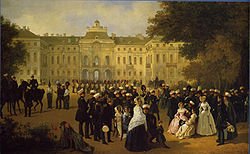- Imperial Guard (Russia)
-
The Russian Imperial Guard, officially known as the Leib Guard (Russian: Лейб-гвардия pronounced "leyb-gvardiya", from German Leib, meaning body; cf Body Guards) were military units serving as personal guards of the Emperor of Russia. Peter the Great founded the first such units following the Prussian practice in the 1690s, to replace the politically-motivated Streltsy.
Contents
Organization
The final composition of the Russian Imperial Guard at the beginning of 1914 was:
Guards Corps St. Petersburg District. Headquarters, St. Petersburg, Millionaya. (Guards units not part of the Guards Corps were the Guards Replacement Cavalry Regiment and Guards Field Gendarme Squadron.)
- 1st Guards Infantry Division. Headquarters, St. Petersburg, Fontanka
- 1st Brigade: Life-Guards Preobrazhensky Regiment, Life-Guards Semenovsky Regiment
- 2nd Brigade: Life-Guards Izmailovsky Regiment, Life-Guards Egersky Regiment
- 1st Life-Guards Artillery Brigade
- 2nd Guards Infantry Division. Headquarters, St. Petersburg, Fontanka[1]
- 1st Brigade: Life-Guards Moscow Regiment, Life-Guards Grenadier Regiment
- 2nd Brigade: Life-Guards Pavlovskii Regiment, Life-Guards Finland Regiment
- 2nd Life-Guards Artillery Brigade
- 1st Guards Cavalry Division. Headquarters, St. Petersburg, Fontanka
- 1st Brigade: Her Sovereign Majesty Empress Maria Theodorovna's Chevalier Guard Regiment, Life-Guards Horse Regiment
- 2nd Brigade: His Majesty's Life-Guards Cuirassier Regiment, Her Majesty Empress Maria Theodorovna's Life-Guards Cuirassier Regiment
- 3rd Brigade: His Majesty's Life-Guards Cossack Regiment, His Imperial Highness the Sovereign Heir and Tsesarevich's Life-Guards Ataman Regiment, Life-Guards Combined Cossack Regiment, 1st His Majesty's Ural Sotnia, 2nd Orenburg Sotnia, 3rd Combined Sotnia, 4th Amur Sotnia
- 1st Division of Life-Guards Horse-Artillery Brigade
- 2nd Guards Cavalry Division. Headquarters, St. Petersburg, Fontanka
- 1st Brigade: Life-Guards Horse-Grenadier Regiment, Her Majesty Empress Alexandra Theodorovna's Life-Guards Lancer Regiment
- 2nd Brigade: Life-Guards Dragoon Regiment, His Majesty's Life-Guards Hussar Regiment
- 2nd Division of Life-Guards Horse-Artillery Brigade
- Guards Rifle Brigade. Headquarters, St. Petersburg, Fontanka
- Life-Guards 1st His Majesty's Rifle Regiment
- Life-Guards 2nd Tsarskoe-Selo Rifle Regiment
- Life-Guards 3rd His Majesty's Rifle Regiment
- Life-Guards 4th The Imperial Family's Rifle Regiment
- Guards Rifle Artillery Battalion
- Life-Guards Horse Artillery
- Guards Howitzer Artillery Battalion
- Life-Guards Sapper Battalion
- Guards Aviation Company
Plus the following were part of the 23rd Army Corps, Warsaw Military District. Headquarters, Warsaw, Poland.
- 3rd Guards Infantry Division. Headquarters, Warsaw.
- 1st Brigade: Life-Guards Lithuania Regiment, Emperor of Austria's Life-Guards Kexholm Regiment
- 2nd Brigade: King Frederick-William III's Life-Guards St.-Petersburg Regiment, Life-Guards Volynski Regiment
- 3rd Life-Guards Artillery Brigade
- 2nd Infantry Division
- Separate Guards Cavalry Brigade
- 3rd Battery of Life-Guards Horse Artillery
- 23rd Howitzer Artillery Battalion
- 9th Sapper Battalion
Ranks
Every soldier and officer of the Guard had the style of the Leib Guard (Лейб-гвардии ...), for example: Colonel of the Leib Guard (Лейб-гвардии полковник). It is a misconception that the monarch himself functioned as the commander of the Leib Guard regiments, so only he and some members of royal family could hold a title of Colonel (Polkovnik) of the Guards, but in fact there were many guards officers in the rank of colonel.[specify]
Commissioned officers enjoyed a two-grade elevation in the Table of Ranks over regular army officers; this later changed to a one-grade elevation -- first for the New Guards then for the rest of the Leib Guard. Following the abolition of the rank of Major in 1884, most grades below VII shifted one position upwards, effectively returning to those of the Old Guards.
Grade, Old Guards Grade, New Guards Category Infantry Cavalry, Cossacks until 1891 Cossacks (since 1891) IV V Staff Officers Colonel (Полковник) V VI Junior Colonel (Подполковник) (until 1798); VI VII Premier Major, Second Major (Премьер-майор, секунд-майор) (until 1798) VII VIII Ober-Officers Captain (Капитан) Rittmeister (Ротмистр) Yesaul (Есаул) VIII IX Staff-Captain (Штабс-капитан) Staff-Rittmeister (Штабс-ротмистр) Junior Yesaul (Подъесаул) IX X Poruchik (Поручик) Sotnik (Сотник) X XI Junior Poruchik (Подпоручик) Khorunzhiy (Хорунжий) XI XII Praporshchik (Прапорщик) Cornet (Корнет) XII XIII Under-Officers Feldwebel (Фельдфебель) XIII XIV Sergeant (Сержант) Feldwebel (1800-1884) Wachtmeister (Вахмистр) Junior Khorunzhiy (Подхорунжий) XIV Junior Praporshchik (Подпрапорщик); Senior Unteroffizier (Старший унтер-офицер) since 1800 Wachtmeister (Вахмистр) Unteroffizier (Унтер-офицер) Uryadnik (Урядник) Gefreiter (Ефрейтор) Prikazny (Приказный) Privates Musketeer, Fusilier, Grenadier etc. (Мушкетер, фузилер, гренадер и т.д.) Dragoon, Hussar, Cuirassier, Cossack etc. (Драгун, гусар, кирасир, казак и т.д.) Cossack (Казак) References
- ^ References in Russian see * Полный список шефу, бригадным, дивизионным и батарейным командирам и офицерам Лейб-гвардии 2-й артиллерийской бригады. СПб., 1898г. 327 с. and Журнал боевых действий 2-ой Гвардейской Пехотной Дивизии 1915 г. Париж, 1930. 32 с.
See also
Categories:- Russian Imperial Guard
- Military units and formations of the Russian Empire
- Royal Guards
- Russian military units and formations of the Napoleonic Wars
- 1st Guards Infantry Division. Headquarters, St. Petersburg, Fontanka
Wikimedia Foundation. 2010.

